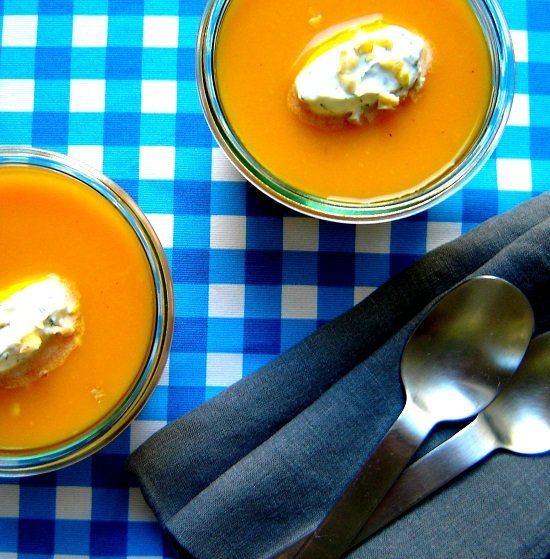French Humor & A Thanksgiving Soup Recipe
Well, here we are in Paris, once again in lockdown. Maybe I have too much time on my hands…. So let’s consider the apostrophe!
If there’s one thing that consistently drives me crazy about living in France, it’s the misuse of apostrophes. Even though I give the French a big break on this one, since there aren’t any possessive apostrophes in their language, some folks seem to take a malin plaisir, or malicious pleasure, in mangling words of English-language origin by using apostrophes in awkward places.
But the longer I live in France, the more I find that the things that once drove me crazy about French people are precisely the things I find humorous about them now. You might already have noticed, especially in Paris, that the word “jeans” is often spelled with a pesky apostrophe: jean’s. So I couldn’t help laughing one day when I sat behind this guy on the bus whose label blatantly flounced all notions of correct apostrophe usage in English.

Second degree humor
Taking the man’s jacket label literally, and deliberately ignoring the fact that Jean-Paul Gaultier is a famous designer, would mean that Paul Gaultier belongs to a person named Jean, I suppose. But who would take this literally, or in the first degree, as the French call it? An English-speaking apostrophe nut? Guilty as charged.
So why does this label no longer upset my sense of propriety concerning apostrophe usage? I think I’ve finally started to understand what the French call second degree humor. Maybe it’s just me, but I find it pretty funny that even a famous designer could use this very French sense of irony right on his jacket’s label, when even the label itself is a play on words between the designer’s first name and his line of jean’s jeans.

Hi! I’m Allison, and I’m an Edutainer working in French food, culture, history, and art. If you’re a gastro-curious traveler or learner, I’m here to show you the A to Z of French food and culture!

CATEGORY
ALL RECIPES
Cocktails & Party Recipes
DESSERTS & SWEETS
MAIN COURSES
OTHER FIRST COURSES
SIDE DISHES
SOUPS & SALADS
Not terrible, or pas terrible?
Americans are often accused in French culture of taking thing too literally, at face value – premier degré. But how do you actually use second degree humor? One expression we use in the second degree is Ce n’est pas terrible or more often, it’s pronounced without the ne: C’est pas terrible. Literally, this means something’s not terrible, not bad.
But seen through the second degree lens, it’s not terrific, meaning it’s actually, truly terrible. People I know usually scrunch up their nose as they pronounce this expression, to show their dislike of whatever is pas terrible. There are plenty of other really great examples of French second-degree expressions, some of which you can find on this web site.
Scallops vs. St. Jacques
Well okay, so what if the French misuse English-language words and apostrophes? Maybe they think that using one will confer a sense of anglo “cool” on their brands, businesses, and other official names. But wait a minute… Don’t we also use French words to confer more panache or more cachet (hmmm…) to a product?
Take scallops for example. When did they become St. Jacques on American menus? Or en croute – why not just say in a pastry or a salt crust? Another example is velouté: it literally means something velvety, and in classic French cuisine refers to one of the five mother sauces. But it’s also used nowadays for any puréed, creamed soup. Does velouté look better on a menu than “puréed, creamed soup”? You bet.
Shan tee yee
There’s one word that I see almost universally misused on menus, no matter where I am: Chantilly. The word “Chantilly” is considered an appellation, or official name, and as far as classic French cuisine is concerned it means one thing, and one thing only: whipped cream with the addition of confectioner’s sugar, and vanilla beans scraped straight from the pod.
But this term has been hijacked and transformed to refer to savory whipped creams, which are a delicately pretty and delicious addition to soups or little aperitif toasts, like this recipe for Chantilly salée citron fines herbes. Or the herb Chantilly that accompanies the soup recipe below. And frankly, doesn’t Chantilly [shan tee yee] sound so much nicer than whipped cream?

Disc-eaters and bubble chairs
This Pumpkin Chestnut Soup recipe comes not from Jean-Paul Gaultier, but from my friend Jean. His affinity for Pumpkin Chestnut Soup could be explained by his love of monochromatic mid-century objects. The color? You guessed it: orange.
Jean has transformed his adventures in finding orange objects into an art form: in and around Paris, he scours junk shops, flea markets, and vide-greniers (literally attic-emptyings, or what we call yard sales). His sole aim is to unearth inexpensive orange objects like portable vinyl record players called mange-discs or bubble chairs.

Oversize plastic dice, bar kits, and lampshades all fit the bill, as well as the occasional Eames shell chair, by American designing couple Charles and Ray Eames. (I saw this display recently at BHV Marais. Note the steel wire “Eiffel Tower” base of the chair in the middle!).

Autumn dinner parties or Thanksgiving
You can imagine why Pumpkin Chestnut Soup is Jean’s favorite: its gorgeous color. It announces autumn just as surely as the first snap of pleasant cold that grabs my gut on the way to the market – or was that a hunger pang?
When I get to the market, I buy is the small round variety of pumpkin known as potimarron, a mix of the two words potiron (pumpkin) and marron or chestnut. Its flesh is sweet and dense with starch, and tastes a little like chestnuts, hence the name. In English, the pumpkin is called Hokkaido or Red kuri squash.
I’ve dressed up this recipe with the addition of chestnuts, a very French ingredient, a bit of Cointreau (or use any orange-flavored liqueur), and yes, an herb Chantilly. These ingredients make this soup perfect for autumn dinner parties or even a festive fall occasion like Thanksgiving! And what’s great about most forms of pumpkin is that they’re economical vegetables – a hell of a lot more affordable than an Eames chair!

Jean’s Pumpkin Chestnut Soup
ingredients:
- 1 tablespoon (15 g) butter
- 1 medium leek (about 5-7 ounces or 150-200 g), white part only, washed and roughly chopped
- 2 medium carrots (5 ounces or 140 g), peeled and roughly chopped
- 1 lb.14oz. – 2.2 lbs. (850 g – 1 kg) Hokkaido or Red kuri squash, cut in half, emptied, peeled (optional, see note below) and cut into 1-inch (2.5 cm) cubes
- 7 cups (1.6 liters) water, vegetable stock, or light chicken stock
- 2 teaspoons coarse sea salt (or to taste)
- about 5 twists of a pepper mill
- 1 generous cup (160 g) peeled and roasted chestnuts (use fresh chestnuts if you’re extremely courageous, otherwise use frozen or from a jar)
- 2 tablespoons freshly squeezed orange juice
- 2 teaspoons Cointreau
- 2 tablespoons crème fraîche (or heavy cream), optional
for herb Chantilly (whipped cream garnish), optional:
- ⅓ cup (about 80 ml) heavy cream, very cold
- ¼ cup (about 30 g) chopped chives or chervil, or other herbs

how to make it:
- In a large soup pot, melt the butter over medium heat.
- Add the leeks and carrots and sauté until slightly caramelized (light brown-colored), about 5-7 minutes, stirring from time to time.
- If you’re making the herb Chantilly, put a medium bowl and a hand whisk or beaters in the refrigerator to make sure they’re extra-cold.
- Add the pumpkin cubes and stir well, and let cook about 3 minutes more.
- Add water or stock, and bring to the boil. Add salt and pepper.
- Lower the heat and let the soup simmer, partially covered, for 15-20 minutes. Skim and throw away any foam that rises to the surface.
- Reserve 4 chestnuts. Add the others to the soup, and continue to simmer about 10 more minutes.
- Remove from heat and add the orange juice and Cointreau. Let the soup cool for about 10 minutes.
- Using an immersion blender, purée the soup until it is smooth. If your pumpkin was on the heavy/big side, this purée will be too thick, so feel free to thin it with water or stock.
- If you are making the herb Chantilly, whip the cream to medium peaks using a whisk or hand-held beater. You don’t want to over-whip, but it’s important to find the texture that will support the weight of the chopped chestnut garnish. When you quickly lift the whisk from the cream, it should make what we call a bec d’oiseau, or bird’s beak (see photo).
- Gently fold the herbs into the whipped cream using a rubber spatula.
- Reheat the soup gently over low heat, and stir in the optional crème fraîche. The soup should be warmed through, but not boiling.
- Chop the reserved chestnuts.
- Taste the soup for seasoning and texture. Serve it as thick or as thin as you like.
- Serve the soup right away in shallow bowls for a first course, or deep bowls if you’re dining light on just this warming soup and a few slices of toasted whole-grain bread.
- If you made the herb Chantilly, make a little oblong quenelle (or dumpling) by using two tablespoons to shape the quenelle, and place it on the soup. (Or you can use a pastry bag and tip to pipe a bit of the Chantilly on top.) Then sprinkle a bit of chopped chestnuts on top of the Chantilly.
6 to 8 first course servings; 3 to 4 main course servings
note: Preparing pumpkin isn’t as hard as it seems, although I’ll admit peeling the hard outer rind can seem intimidating. Did you know that you don’t even have to peel this small pumpkin? But peeling does make for a smoother soup.
Start by cutting the entire pumpkin in half down the middle, using a large chef’s knife, and rather than sawing, don’t hesitate to remove the knife, turn the pumpkin a quarter turn, and make a cut further along that will eventually join the first one in the middle. Keep your hand flat on the top of the chef’s knife.
Once you’ve got two halves, remove the stringy insides and seeds, and place one half flat on the cutting board. Then either:
Do what astute home chefs do:
Use a Y-peeler (see photo) to peel the rind away. Easy!
Do what professional chefs do:
Use a serrated (bread) knife to cut away the rind, cutting always away from you and downwards, turning the pumpkin half as you go. The only tricky part is the top of the demi-sphere, but just keep the knife pointed away from you and cut nearly horizontally.



Delicious, warming soup for the cold season! I was grateful for the tip on how to prepare the pumpkin, as I’ve always had a hard time peeling winter/root vegetables. Thanks for the photo of the bird’s beak too – it’s helpful to know how “stiff” to make the cream. I will definitely make this again, yum!
Hi Katherine! I’m so glad you found the recipe useful and delicious. Thanks for your comment!
I love pumpkin soup with chestnuts! It’s the perfect fall/winter soup. I usually make it for American Thanksgiving in France, as my friends here tend to balk at pumpkin pie, but adore pumpkin soup. The Cointreau is an interesting touch. Instead of carrots, I add a couple potatoes to give it body. This past Thanksgiving, I sautéed wild mushrooms with lardons and broken chestnuts and stirred them into the soup before serving.
Your version of the soup sounds wonderful! I agree on the potato: when I’m making a pumpkin soup for (just) us and the kids, I also like to give the recipe a bit more body with a starchy potato.
A few years ago, I learned a fussy restaurant technique for making chestnut “chips” and their crisp is a nice foil for the smooth soup. But grating chestnuts over a mandoline is challenging! Thanks for your comments!
There’s a girl called Jeanne who used to live between Ménilmontant and Belleville, whose pumpkin soup delights my daughter (who’s totally refractory to my own version of this classic). Maybe the presence of Cointreau in the recipe would tempt her into making this one? I remember we’d met Jean-Paul Gaultier (the real one, not the counterfeit 🙂 don’t you think the jacket you mention was one, actually? So maybe the irony here was Chinese, I don’t know) on the street while we where doing a happening in the Marais and he wasn’t precisely amiable. I think we’d frightened him with our outfits – and that’s quite a thing if you consider he created a few scandalous clothes himself. Or was it our fake pistols?!? Anyway, thanks for the tip: I never thought about using a peeler on a pumpkin before, that will probably save my fingers in the future!
I think I know the person you mention! And her soup recipe is probably similar to mine. But we’ll have to have a Great Pumpkin Soup Cook-off with a blind taste-taste to find out!
And yes, the peeler works wonders. Or, you can use one of your pistols to peel the pumpkin Swedish-chef style. Happy cooking!
Allison